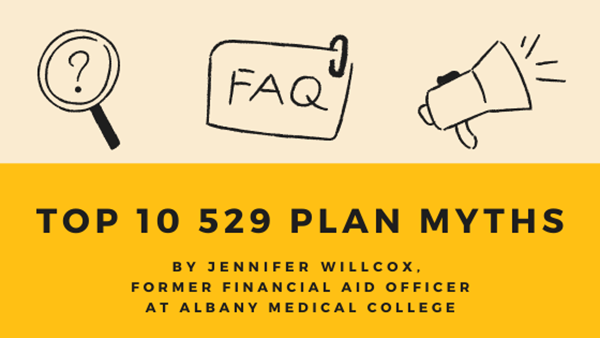Top 10 529 Plan Myths
Lots of misinformation surrounds 529 savings plans, a college-specific savings vehicle that has existed for over 35 years. Often, when I ask a family, “Do you have a 529?” my question is followed by a resounding, “No, we didn’t start one because…”
Let’s bust some myths! This topic might not be as exciting as the Discovery Channel’s hit television show Mythbusters where Adam Savage and Jamie Hyneman use scientific methods to test the validity of rumor and the myths of movie scenes, internet videos, and news stories. However, with the rising cost of college, saving is a key component for success and I think it is very exciting that research shows that families who save for education can end up paying two to three times less for college than families who borrow.
MYTH #1: If I save money in a 529, my student won't receive financial aid.
The balance in your 529 plan is reported when determining your student’s financial aid eligilbity, however, the impact is minimal. A 529 plan owned by a custodial parent or dependent student counts as a parent's asset on the FAFSA, and it may reduce need-based aid by a maximum of 5.64% of the 529 account’s value.
MYTH #2: You can only attend college in the state where your 529 plan is.
Your student can go to college in any state, regardless of which state sponsors your particular plan.
MYTH #3: A 529 plan restricts access to my money.
You will always have access to your money, however, if you do not use your funds for qualified educational expenses you will owe taxes and a penalty on the earnings of your withdrawal. Your principal balance remains tax and penalty free.
MYTH #4: I can only use the funds for a traditional four-year college.
A 529 plan allows families to save for many different types of post-secondary education and training: K-12 tuition expenses (up to $10,000 per year; not available in all states), technical or vocational schools, two-year and four- year colleges, and even student loan repayment (up to $10,000 lifetime limit).
MYTH #5: If my student receives a scholarship I will lose the money.
If your student wins a scholarship you can still use your money and pay for qualified education-related expenses not covered by the scholarship, such as room and board, books, supplies, and computer technology. You can transfer any unused funds to an eligible family member or save the unused money for graduate school or student loan repayment.
MYTH #6: A 529 plan can only be used to pay for tuition.
529 plans are eligible to be used for qualified college educational expenses: tuition, fees, room, board, books, approved supplies, computer technology, and student loan repayment.
MYTH #7: If my child decides not to go to college I will lose my money.
There is no time limit to spend down the money in your 529 account; your student can always decide to attend college at a later date. To avoid making a nonqualified withdrawal, account owners may consider changing the account beneficiary to an eligible family member or using the funds to pay qualified educational expenses at K–12 schools, vocational/technical schools, apprenticeship programs, or on student loan repayment.
MYTH #8: It costs a lot of money to start an account.
Most plans require a minimal contribution to open an account. Future contributions can be made at any time.
MYTH #9: 529 Plans are difficult to open and maintain.
Every 529 plan is managed by an investment firm that offers services of a financial professional who will be able to help you with goal setting, allocations, and investment selections. If you want someone else to manage your plan you can opt to invest in an advisor-sold 529 plan.
MYTH #10: It’s too late to open a 529 account if my student is in high school.
It is never too late to start saving. Everyone has different goals and financial situations. Maybe your goal is to save enough to help cover books and part of tuition with your 529 plan. Some families will try to save for all educational costs. Regardless, the account will still offer the same benefits: tax-free withdrawals for qualified educational expenses and a possible state tax deduction on your contributions (if offered by your state and you qualify; check your state’s 529 plan for more information).
The days of a student being able to work a summer job so they can afford to pay for a tuition bill are long gone. Families need to plan for college in the same way they plan to buy a home or save for retirement. A 529 plan can be a useful savings tool and will provide your student with more options. What better gift can you provide your student than investing in their future?






